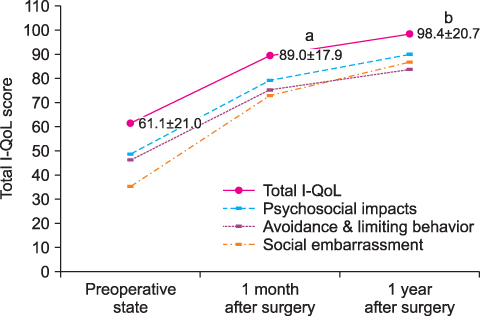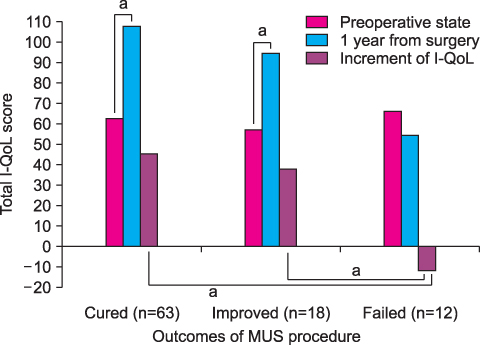Korean J Urol.
2010 Feb;51(2):122-127.
Impact of the Midurethral Sling Procedure on Quality of Life in Women with Urinary Incontinence
- Affiliations
-
- 1Department of Urology, College of Medicine, Yeungnam University, Daegu, Korea. junghc@ynu.ac.kr
Abstract
-
PURPOSE: This study was designed to objectively assess the impediment of incontinence to quality of life (QoL) in females and its improvement by the midurethral sling (MUS) procedure.
MATERIALS AND METHODS
From June 2006 to June 2007, 93 female patients underwent the MUS procedure at our institute because of urinary incontinence. The incontinence quality of life (I-QoL) questionnaire was administered to measure the QoL of the incontinent patients before and 1 and 12 months after the MUS procedure. Preoperative data and urodynamic factors were analyzed retrospectively by I-QoL scores to identify factors that may affect the QoL of incontinent patients.
RESULTS
The average preoperative I-QoL score of the 93 patients was 61.1+/-21.0 points. At 1 year after surgery, the average I-QoL score was found to have improved to 98.4+/-20.7 points. There were no significant differences between stress and mixed urinary incontinence in terms of cure and satisfaction (p>0.05). I-QoL scores of the cured and improved patients increased at 1 year after surgery (p<0.01). There were no statistically significant differences in the increment of I-QoL between cured and improved patients (p>0.05). Although urinary urgency and large urine leak amounts significantly reduced preoperative QoL in incontinent patients, the MUS procedure effectively improved the QoL regardless of these factors.
CONCLUSIONS
Preoperative I-QoL assessment revealed a significant impairment of QoL in incontinent women, but the MUS procedure effectively improved these women's QoL.
MeSH Terms
Figure
Reference
-
1. Campeau L, Tu LM, Lemieux MC, Naud A, Karsenty G, Schick E, et al. A multicenter, prospective, randomized clinical trial comparing tension-free vaginal tape surgery and no treatment for the management of stress urinary incontinence in elderly women. Neurourol Urodyn. 2007. 26:990–994.2. Kim JC, Chung BS, Choi JB, Lee JY, Lee KS, Park WH, et al. A safety and quality of life analysis of intravaginal slingplasty in female stress incontinence: a prospective, open label, multicenter, and observational study. Int Urogynecol J Pelvic Floor Dysfunct. 2007. 18:1331–1335.3. Choo MS. Recent trends in the surgical treatment of female stress urinary incontinence. Korean J Urol. 2004. 45:509–517.4. Song PH, Hyun CH, Lim HS, Jung HC. Five-year outcomes of the IRIS procedure for the treatment of female stress urinary incontinence: comparison with the TVT procedure. Korean J Urol. 2009. 50:767–773.5. Wagner TH, Patrick DL, Bavendam TG, Martin ML, Buesching DP. Quality of life of persons with urinary incontinence: development of a new measure. Urology. 1996. 47:67–71.6. Abrams P, Blaivas JG, Stanton SL, Andersen JT. The standardisation of terminology of lower urinary tract function. The International Continence Society Committee on Standardisation of Terminology. Scand J Urol Nephrol Suppl. 1988. 114:Suppl. 5–19.7. Oh SJ, Park HG, Lim SH, Hong SK, Kim SW, Kim HH, et al. Translation and linguistic validation of Korean version of the incontinence quality of life (I-QoL) instrument. J Korean Continence Soc. 2002. 6:10–23.8. Stamey TA. Endoscopic suspension of the vesical neck for urinary incontinence in females. Report on 203 consecutive patients. Ann Surg. 1980. 192:465–471.9. Kelleher CJ, Cardozo LD, Khullar V, Salvatore S. A new questionnaire to assess the quality of life of urinary incontinent women. Br J Obstet Gynaecol. 1997. 104:1374–1379.10. Donovan J, Bosch R, Corcos J, Gotoh M, Kelleher C, Naughton M. Abrams P, Cardozo L, Khoury S, Wein A, editors. Symptom and quality of life assessment. Incontinence. 2002. 2nd ed. Plymouth: Health Publication;267–316.11. Papanicolaou S, Hunskaar S, Lose G, Sykes D. Assessment of bothersomeness and impact on quality of life of urinary incontinence in women in France, Germany, Spain and the UK. BJU Int. 2005. 96:831–838.12. Kocjancic E, Crivellaro S, Oyama IA, Singla A, Ranzoni S, Carone R, et al. Transobturator tape in the management of female stress incontinence: clinical outcomes at medium term follow-up. Urol Int. 2008. 80:275–278.13. Meschia M, Pifarotti P, Bernasconi F, Magatti F, Vigano R, Bertozzi R, et al. Tension-free vaginal tape (TVT) and intravaginal slingplasty (IVS) for stress urinary incontinence: a multicenter randomized trial. Am J Obstet Gynecol. 2006. 195:1338–1342.14. Chene G, Tardieu AS, Cotte B, Chauleur C, Savary D, Krief M, et al. Health-related quality of life in women operated on by surgical anti-incontinence procedures: comparison of three techniques. Gynecol Obstet Fertil. 2009. 37:3–10.15. Iglesias X, Espuña M. Surgical treatment of urinary stress incontinence using a method for postoperative adjustment of sling tension (Remeex System). Int Urogynecol J Pelvic Floor Dysfunct. 2003. 14:326–330.
- Full Text Links
- Actions
-
Cited
- CITED
-
- Close
- Share
- Similar articles
-
- Urethral Erosion and Perineal Cellulitis after Midurethral Sling Procedure
- The Influence of Preoperative Bladder Outlet Obstruction on Continence and Satisfaction in Patients with Stress Urinary Incontinence after Midurethral Sling
- Current Overview of Surgical Options for Female Stress Urinary Incontinence
- Impact of Body Mass Index on Postoperative Urinary Symptoms after Miduretheral Sling Surgery in Female Patients
- Changes in Sexual Function after the Midurethral Sling Procedure for Stress Urinary Incontinence: Long-term Follow-up



